Pyplot vs Object Oriented Interface
Posted
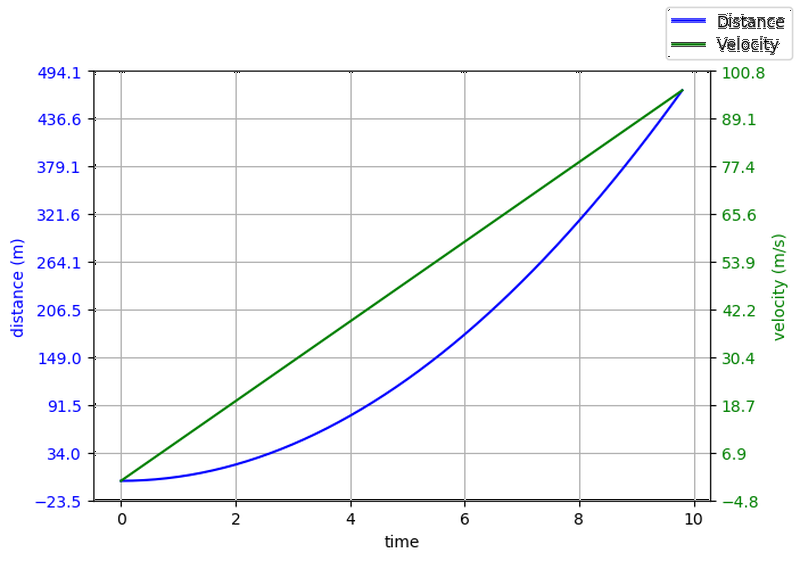
Generating the data points
To get acquainted with the basics of plotting with matplotlib, let's try plotting how much distance an object under free-fall travels with respect to time and also, its velocity at each time step.
If, you have ever studied physics, you can tell that is a classic case of Newton's equations of motion, where
$$ v = a \times t $$
$$ S = 0.5 \times a \times t^{2} $$
We will assume an initial velocity of zero.
import numpy as np
time = np.arange(0., 10., 0.2)
velocity = np.zeros_like(time, dtype=float)
distance = np.zeros_like(time, dtype=float)
We know that under free-fall, all objects move with the constant acceleration of $$g = 9.8~m/s^2$$
g = 9.8 # m/s^2
velocity = g * time
distance = 0.5 * g * np.power(time, 2)
The above code gives us two numpy arrays populated with the distance and velocity data points.
Pyplot vs. Object-Oriented interface
When using matplotlib we have two approaches:
pyplotinterface / functional interface.- Object-Oriented interface (OO).
Pyplot Interface
matplotlib on the surface is made to imitate MATLAB's method of generating plots, which is called pyplot. All the pyplot commands make changes and modify the same figure. This is a state-based interface, where the state (i.e., the figure) is preserved through various function calls (i.e., the methods that modify the figure). This interface allows us to quickly and easily generate plots. The state-based nature of the interface allows us to add elements and/or modify the plot as we need, when we need it.
This interface shares a lot of similarities in syntax and methodology with MATLAB. For example, if we want to plot a blue line where each data point is marked with a circle, we can use the string 'bo-'.
import matplotlib.pyplot as plt
plt.figure(figsize=(9,7), dpi=100)
plt.plot(time,distance,'bo-')
plt.xlabel("Time")
plt.ylabel("Distance")
plt.legend(["Distance"])
plt.grid(True)
The plot shows how much distance was covered by the free-falling object with each passing second.
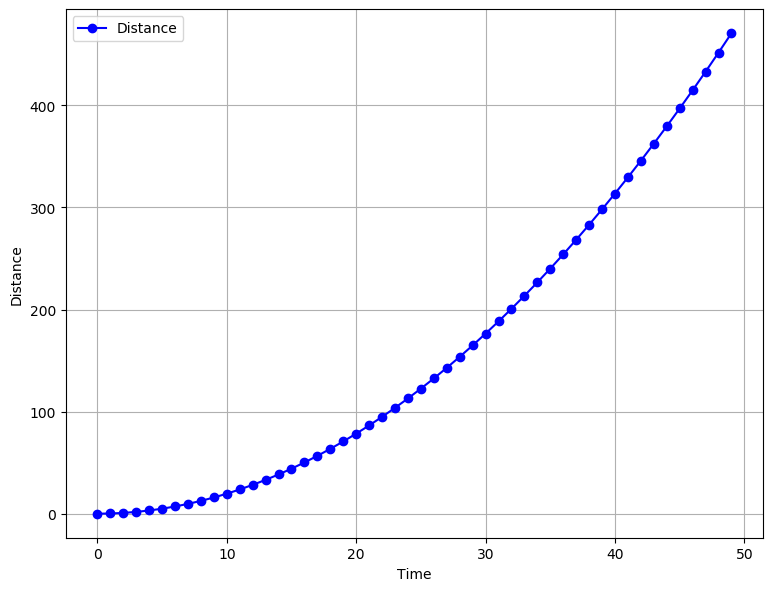
plt.figure(figsize=(9,7), dpi=100)
plt.plot(time, velocity,'go-')
plt.xlabel("Time")
plt.ylabel("Velocity")
plt.legend(["Velocity"])
plt.grid(True)
The plot below shows us how the velocity is increasing.
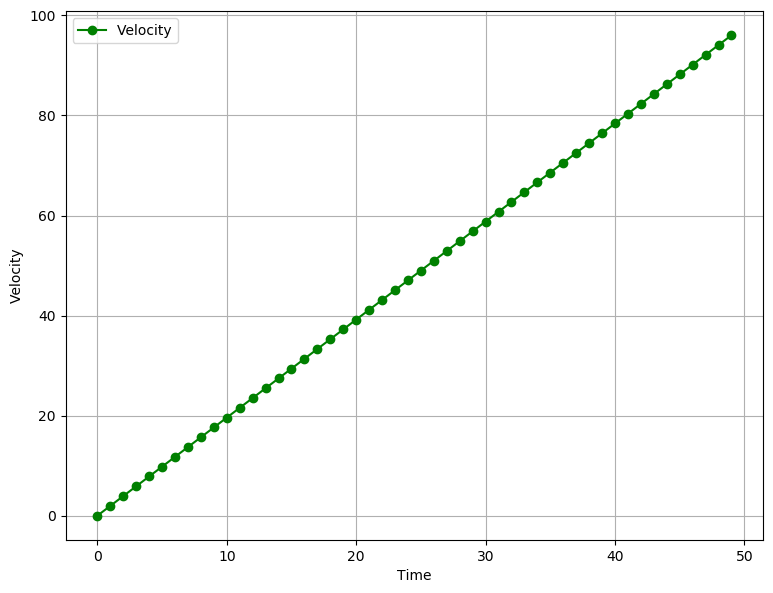
Let's try to see what kind of plot we get when we plot both distance and velocity in the same plot.
plt.figure(figsize=(9,7), dpi=100)
plt.plot(time, velocity,'g-')
plt.plot(time, distance,'b-')
plt.ylabel("Distance and Velocity")
plt.xlabel("Time")
plt.legend(["Distance", "Velocity"])
plt.grid(True)
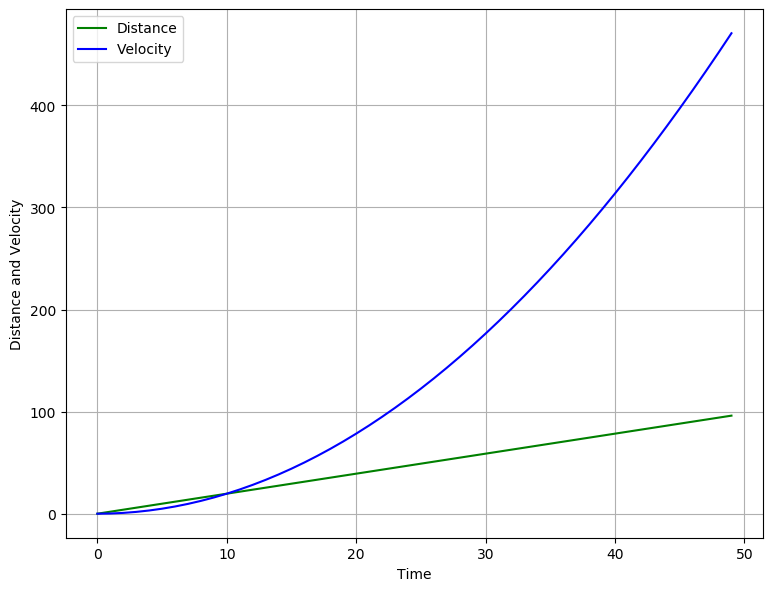
Here, we run into some obvious and serious issues. We can see that since both the quantities share the same axis but have very different magnitudes, the graph looks disproportionate. What we need to do is separate the two quantities on two different axes. This is where the second approach to making plot comes into play.
Also, the pyplot approach doesn't really scale when we are required to make multiple plots or when we have to make intricate plots that require a lot of customisation. However, internally matplotlib has an Object-Oriented interface that can be accessed just as easily, which allows to reuse objects.
Object-Oriented Interface
When using the OO interface, it helps to know how the matplotlib structures its plots. The final plot that we see as the output is a ‘Figure’ object. The Figure object is the top level container for all the other elements that make up the graphic image. These “other” elements are called Artists. The Figure object can be thought of as a canvas, upon which different artists act to create the final graphic image. This Figure can contain any number of various artists.

Things to note about the anatomy of a figure are:
- All of the items labelled in blue are
Artists.Artistsare basically all the elements that are rendered onto the figure. This can include text, patches (like arrows and shapes), etc. Thus, all the followingFigure,AxesandAxisobjects are also Artists. - Each plot that we see in a figure, is an
Axesobject. TheAxesobject holds the actual data that we are going to display. It will also contain X- and Y-axis labels, a title. EachAxesobject will contain two or moreAxisobjects. - The
Axisobjects set the data limits. It also contains the ticks and ticks labels.ticksare the marks that we see on a axis.
Understanding this hierarchy of Figure, Artist, Axes and Axis is immensely important, because it plays a crucial role in how me make an animation in matplotlib.
Now that we understand how plots are generated, we can easily solve the problem we faced earlier. To make Velocity and Distance plot to make more sense, we need to plot each data item against a seperate axis, with a different scale. Thus, we will need one parent Figure object and two Axes objects.
fig, ax1 = plt.subplots()
ax1.set_ylabel("distance (m)")
ax1.set_xlabel("time")
ax1.plot(time, distance, "blue")
ax2 = ax1.twinx() # create another y-axis sharing a common x-axis
ax2.set_ylabel("velocity (m/s)")
ax2.set_xlabel("time")
ax2.plot(time, velocity, "green")
fig.set_size_inches(7,5)
fig.set_dpi(100)
plt.show()
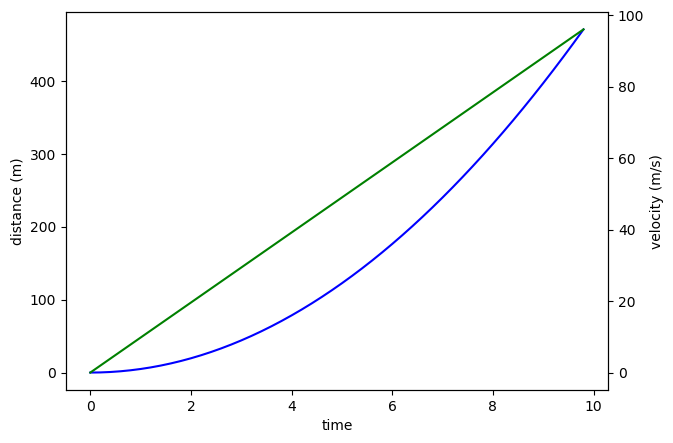
This plot is still not very intuitive. We should add a grid and a legend. Perhaps, we can also change the color of the axis labels and tick labels to the color of the lines.
But, something very weird happens when we try to turn on the grid, which you can see here at Cell 8. The grid lines don't align with the tick labels on the both the Y-axes. We can see that tick values matplotlib is calculating on its own are not suitable to our needs and, thus, we will have to calculate them ourselves.
fig, ax1 = plt.subplots()
ax1.set_ylabel("distance (m)", color="blue")
ax1.set_xlabel("time")
ax1.plot(time, distance, "blue")
ax1.set_yticks(np.linspace(*ax1.get_ybound(), 10))
ax1.tick_params(axis="y", labelcolor="blue")
ax1.xaxis.grid()
ax1.yaxis.grid()
ax2 = ax1.twinx() # create another y-axis sharing a common x-axis
ax2.set_ylabel("velocity (m/s)", color="green")
ax2.set_xlabel("time")
ax2.tick_params(axis="y", labelcolor="green")
ax2.plot(time, velocity, "green")
ax2.set_yticks(np.linspace(*ax2.get_ybound(), 10))
fig.set_size_inches(7,5)
fig.set_dpi(100)
fig.legend(["Distance", "Velocity"])
plt.show()
The command ax1.set_yticks(np.linspace(*ax1.get_ybound(), 10)) calculates the tick values for us. Let's break this down to see what is happening:
- The
np.linspacecommand will create a set ofnno. of partitions between a specified upper and lower limit. - The method
ax1.get_ybound()returns a list which contains the maximum and minimum limits for that particular axis (which in our case is the Y-axis). - In python, the operator
*acts as an unpacking operator when prepended before alistortuple. Thus, it will convert a list[1, 2, 3, 4]into seperate values1, 2, 3, 4. This is an immensely powerful feature. - Thus, we are asking the
np.linspacemethod to divide the interval between the maximum and minimum tick values into 10 equal parts. - We provide this array to the
set_yticksmethod.
The same process is repeated for the second axis.
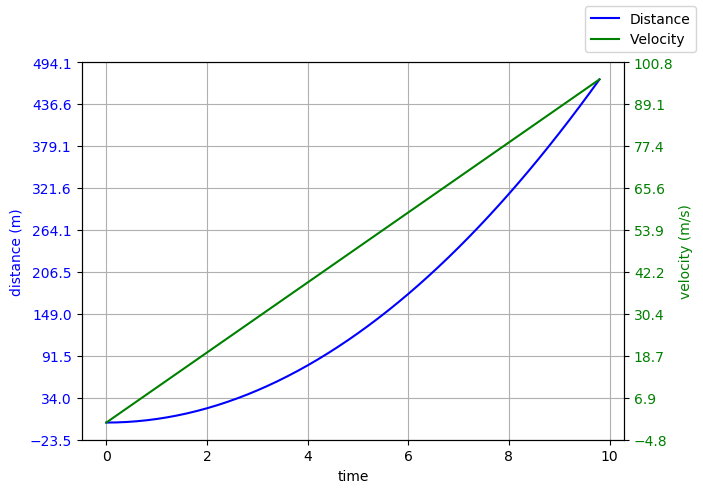
Conclusion
In this part, we covered some basics of matplotlib plotting, covering the basic two approaches of how to make plots. In the next part, we will cover how to make simple animations. If you like the content of this blog post, or you have any suggestions or comments, drop me an email or tweet or ping me on IRC. Nowadays, you will find me hanging around #matplotlib on Freenode. Thanks!
After-thoughts
This post is part of a series I'm doing on my personal blog. This series is basically going to be about how to animate stuff using python's matplotlib library. matplotlib has an excellent documentation where you can find a detailed documentation on each of the methods I have used in this blog post. Also, I will be publishing each part of this series in the form of a jupyter notebook, which can be found here.
The series will have three posts which will cover:
- Part 1 - How to make plots using
matplotlib. - Part 2 - Basic animation using
FuncAnimation. - Part 3 - Optimizations to make animations faster (blitting).
I would like to say a few words about the methodology of these series:
- Each part will have a list of references at the end of the post, mostly leading to appropriate pages of the documentation and helpful blogs written by other people. THIS IS THE MOST IMPORTANT PART. The sooner you get used to reading the documentation, the better.
- The code written here, is meant to show you how you can piece everything together. I will try my best to describe the nuances of my implementations and the tiny lessons I learned.